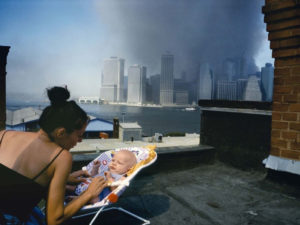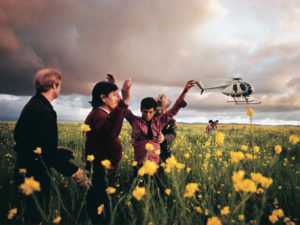You’re a great photographer, you live in New York. You’re walking down the street in Brooklyn and it seems a morning just like any other, when suddenly you notice it isn’t. The people around you are talking confusedly about the Twin Towers, about something awful that is happening at the World Trade Center. No one knows what’s going on – everything’s gridlocked. There’s nothing else for it but to grab your camera and race over there. Meanwhile, however, a man is looking down from a balcony, he realises what you are doing and invites you up. What are you doing? Come up? And what if this is just a ridiculous waste of time?
It is not a silly question because you are a photographer, you need to decide quickly on a day that could be one of the most important and tragic of your life, even if you are yet to understand what the date will mean in the years to come: 11 September 2001
Alex Webb, the actor in this drama, decides to go up and he takes the photograph that you can admire below.

Years have passed but he is still convinced that it was the best photograph he took that day. There is life and there is death. A mother holding her new-born baby, who is blissfully unaware of everything unfolding. Behind him, far away, is Hell…
The writer and journalist, Mario Calabresi, in his fascinating book “Eyes wide open” selects one trait of Webb:
“The most striking thing about his stories and his approach to the world is the complete absence of any theory he is trying to prove; what guides him is the attitude of a searcher who always carries just two tools with him: curiosity and patience. This is why he calls himself a street photographer and not a photojournalist”.
“I always start by walking the streets – writes Webb – letting myself be guided by my experiences with the camera, and without any preconceptions. Maybe I find the same things that a photojournalist finds, but in doing that I start from a different perspective and what I discover is not the fulfilment of a project but something I would never have been able to imagine. Even when I do something that a photojournalist typically does, such as a trip with the border police, I try to keep my mind clear and free, I don’t look for anything I already have in mind, I leave myself open to the possibility of coming across something unexpected. If I had thought “OK, I’m going out with the border police”, I would have imagined taking the usual pictures of arrests.

Instead, this one here that we started from is a picture of an arrest, in a field of flowers bathed in a brilliant light; it is something I could never have imagined. There’s a huge amount of chance in what I do, but that is a choice and it’s important to allow yourself to have it.”
We could define this chance as “fluctuating attention” or, in other words, attention that is uniformly suspended. The opposite, to be clear, of the word “focus”, with which we are more familiar in a work context.
It probably seems to us a luxury we cannot allow ourselves while we are working. We have become very good at creating and following processes within our organisations. An approach that often relates to an economic phase in which the market is seeking margins. We must be careful though, the increase in standardisation not only improves efficiency, it also leads people to neglect behavioural aspects such as attention, curiosity and observation.
Taking inspiration from Webb does not mean driving ourselves to live like lost souls – distracted characters in a world that has to produce. It points, instead, to a possibility that someone can initiate and that can help that person to understand those things that he or she had previously lost sight of.
Innovation in the workplace resides where things happen, where there are problems, weaknesses, anomalies, things that don’t fit our schemes, our processes. If you live too much inside things you lose the ability to see them…
